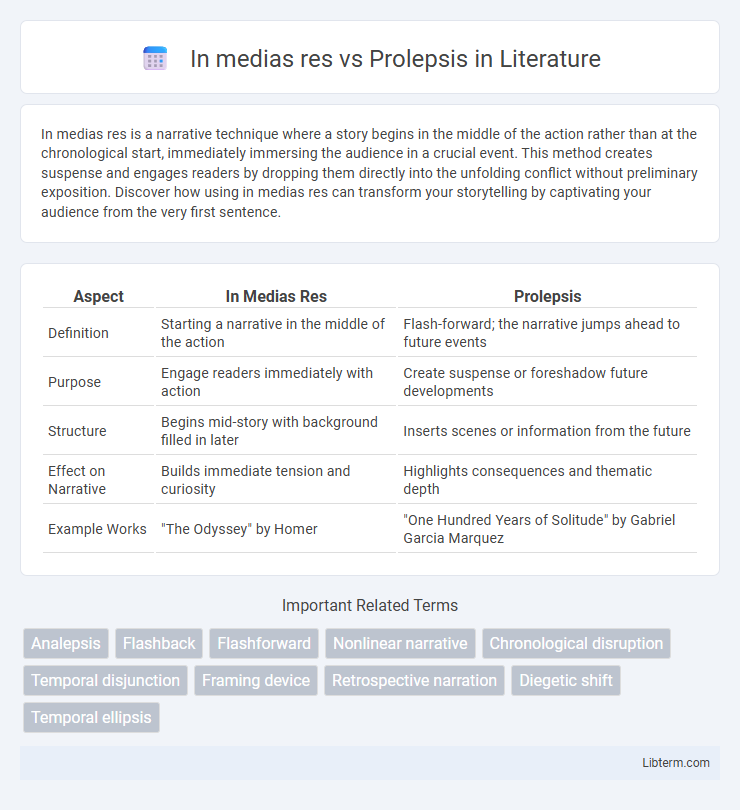In medias res is a narrative technique where a story begins in the middle of the action rather than at the chronological start, immediately immersing the audience in a crucial event. This method creates suspense and engages readers by dropping them directly into the unfolding conflict without preliminary exposition. Discover how using in medias res can transform your storytelling by captivating your audience from the very first sentence.
Table of Comparison
| Aspect | In Medias Res | Prolepsis |
|---|---|---|
| Definition | Starting a narrative in the middle of the action | Flash-forward; the narrative jumps ahead to future events |
| Purpose | Engage readers immediately with action | Create suspense or foreshadow future developments |
| Structure | Begins mid-story with background filled in later | Inserts scenes or information from the future |
| Effect on Narrative | Builds immediate tension and curiosity | Highlights consequences and thematic depth |
| Example Works | "The Odyssey" by Homer | "One Hundred Years of Solitude" by Gabriel Garcia Marquez |
Understanding In Medias Res
In medias res is a narrative technique that begins a story in the middle of the action, bypassing initial exposition to immerse the audience directly into a pivotal event. This method enhances engagement by creating immediate suspense and encouraging the reader to piece together preceding context through flashbacks or dialogue. In contrast, prolepsis involves the anticipation of future events or a flash-forward, but in medias res prioritizes unfolding the present conflict, maximizing dramatic impact from the onset.
Defining Prolepsis in Narrative
Prolepsis in narrative refers to a literary technique where future events or scenes are presented out of chronological order, often as a flashforward to provide insight into upcoming plot developments. This device contrasts with in medias res, which begins a story in the middle of the action without necessarily revealing future outcomes. Prolepsis enhances narrative complexity by creating suspense and anticipation through deliberate temporal shifts within the storyline.
Historical Roots of In Medias Res
In medias res originates from Latin literature, particularly epic poetry like Virgil's "Aeneid," where narratives begin amid crucial action rather than from a chronological start to engage the audience immediately. This technique contrasts with prolepsis, which involves flash-forwards or anticipatory narration revealing future events within the story. The historical roots of in medias res reflect ancient storytelling conventions aimed at captivating audiences through immersive and dynamic plot openings.
Origins and Evolution of Prolepsis
Prolepsis, originating from classical rhetoric and literary theory, traces back to Aristotle's concept of anticipation used to address potential objections by preempting them within the narrative. Throughout its evolution, prolepsis expanded from a purely argumentative tool to a narrative technique that foreshadows future events or presents scenes out of chronological order. This development contrasts with in medias res, which begins a story amid action without prior exposition, highlighting prolepsis's unique role in manipulating temporal structure to enhance storytelling depth.
Structural Impact on Storytelling
In medias res begins a narrative in the midst of action, creating immediate engagement and suspense by immersing the audience without prior context. Prolepsis, or flash-forward, reveals future events to build anticipation and thematic depth, often reshaping audience perceptions of characters and plot developments. Both techniques manipulate chronological structure to enhance narrative complexity, but in medias res emphasizes urgency, while prolepsis prioritizes foreshadowing and interpretation.
Reader Engagement: In Medias Res vs. Prolepsis
In medias res captivates readers by immersing them directly into a pivotal moment of the narrative, sparking immediate curiosity about preceding events. Prolepsis engages audiences through strategic foreshadowing or flash-forwards, creating suspense by hinting at future developments. Both techniques enhance reader engagement by manipulating narrative time to provoke questions and maintain interest throughout the story.
Common Genres Using Each Technique
In medias res is frequently employed in epic poetry and thriller genres to plunge readers directly into critical action or pivotal scenes, intensifying suspense and engagement. Prolepsis, commonly found in science fiction and mystery novels, strategically uses flashforwards or foreshadowing to reveal future events, creating anticipation and deepening narrative complexity. Both techniques enhance storytelling by manipulating temporal structure, with in medias res emphasizing immediate immersion and prolepsis fostering a layered understanding of plot progression.
Famous Examples of In Medias Res
In medias res is a narrative technique where a story begins in the middle of the action, exemplified by Homer's "The Iliad," which plunges directly into the Trojan War, and Dante's "Divine Comedy," starting in a dark forest without prior backstory. Prolepsis, contrastingly, involves flash-forward moments anticipating future events. Famous instances of in medias res create immediate engagement and dramatic tension, as seen in Virgil's "Aeneid" and the film "Pulp Fiction," emphasizing critical plot developments already underway.
Notable Uses of Prolepsis
Notable uses of prolepsis appear in literature such as Homer's *Iliad*, where future events are anticipated to heighten dramatic tension and foreshadow outcomes. Shakespeare frequently employed prolepsis in plays like *Macbeth* to reveal characters' ambitions and inevitable fates before they unfold. In modern storytelling, prolepsis is integral to flashforwards in television series like *Lost*, enhancing narrative complexity by providing glimpses of future plot developments.
Deciding When to Use Each Technique
In medias res plunges the audience directly into the middle of the action, creating immediate engagement and urgency, ideal for stories that benefit from suspense and dynamic pacing. Prolepsis, or flash-forward, strategically reveals future events to build anticipation or foreshadow outcomes, making it effective for narratives that depend on dramatic tension or thematic reinforcement. Choosing between in medias res and prolepsis depends on whether the goal is to immerse readers instantly in ongoing conflict or to shape expectations by previewing critical moments ahead.
In medias res Infographic

 libterm.com
libterm.com